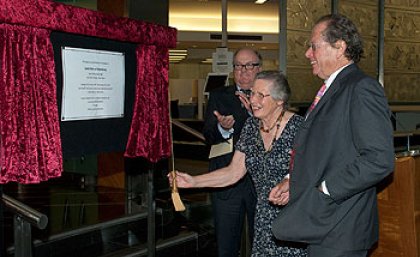
The University of Queensland and the Federal Court of Australia co-hosted an event to commemorate the birthplace of Lord Atkin of Aberdovey, one of the world's most influential common law judges, at a ceremony in Brisbane on Wednesday.
Lord Atkin was born on 28 November 1867 in Tank Street, Brisbane.
Chief Justice of the Federal Court Patrick Keane and Lord Atkin's grandchildren Sir Thomas Atkin Morison and Elizabeth Barry unveiled a commemorative plaque dedicated to Lord Atkin in the Tank Street Courtyard at Brisbane's Commonwealth Law Courts.
The placing of the Lord Atkin plaque was an initiative of UQ’s Dean of Law, Professor Gerard Carney, and the Federal Court of Australia.
Sir Thomas, a retired UK High Court Judge, and Mr and Mrs Barry travelled from the UK to attend the ceremony.
They also visited several local landmarks significant to their great-grandparents’ early days in Queensland after emigrating from the UK during the mid to late 1800’s.
The family said the trip was a wonderful opportunity to discover more about their family’s connection to Queensland.
“I’ve learned more about my family as a result of what Gerard Carney has managed to find out than I ever knew before, so we’re immensely grateful,” Sir Thomas said.
“It’s quite emotional; it isn’t just the memory of my grandfather but of his remarkable parents who were pioneers who came out here after months at sea during which time they lost one family member and were very nearly shipwrecked.”
“Then coming to have 200 square miles of territory in Queensland, it’s a remarkable thing to do, so we have enormous admiration for his parents.”
Mrs Barry said she was particularly delighted to see the display of photographs, books and memorabilia put together by the Federal Court Library to highlight the key events and achievements of Lord Atkin’s life.
Professor Carney said Brisbane should be proud of its connection with one of the most famous judges of the common law world.
“Although he left Australia as a young child, his compassionate judicial philosophy was no doubt influenced by the liberal contribution his parents made to the political life of Brisbane during the early years of the colony,” Professor Carney said.
“Both parents were journalists and his father, Robert, was a prominent member of the Queensland Parliament.”
“I am very grateful to the judges of the Federal Court for supporting this initiative.”
Lord Atkin moved from Brisbane to the UK with his Welsh mother and siblings in 1870 at the age of three, after the early death of his prominent father, Robert Atkin.
After studying at Magdalen College Oxford and reading for the Bar at Gray's Inn, Lord Atkin served as a judge from 1913 until his death in 1944.
He was elevated to the House of Lords in 1928 where he delivered his two most famous judgments in Donoghue v Stevenson in 1932, and Liversidge v Anderson in 1942.
Donoghue v Stevenson, commonly referred to as the “snail in the bottle” case, was a radical step forward in the law of negligence and experts believe that Lord Atkin's judgment contains the most influential statement of legal principle used in the common law world to this day.
The case changed the course of the common law by setting the foundation for the tort of negligence, brought about when one party fails to exercise a reasonable standard of care to prevent harm to another, such as in personal injury claims, product liability and consumer law.
Lord Atkin married Lizzie Hemmant, the eldest daughter of prominent Brisbane businessman and politician, William Hemmant.
Media: Professor Gerard Carney, 07 3365 2361, g.carney@law.uq.edu.au or
Melissa Reynolds, TC Beirne School of Law 07 3365 2523, m.reynolds@law.uq.edu.au
.jpg)










